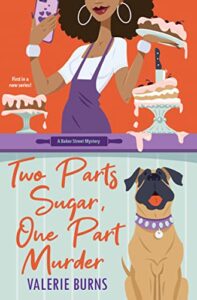They say you never forget your first true love. Mystery, specifically cozy mysteries, were my first love. I remember reading my first Agatha Christie, The Murder of Roger Ackroyd. It blew my mind. When I read, And Then There Were None, I was a goner. Over the years, I wasn’t always faithful to my chosen genre. I went through phases where I strayed and read romance, fantasy, and science fiction, but even the Queen of Crime herself wrote romance novels under the name, Mary Westmacott. Regardless of what other genres I read, I always returned to mysteries. When I decided I wanted to toss my hat into the ring and write books, I knew it would have to be a mystery. But the world has changed a lot since Dame Christie penned her first books. Agatha Christie’s writing reflected a different world and a different era. Christie’s British culture and her experiences as an apothecary’s assistant, a nurse during WWI, and later as an amateur archaeologist are all reflected in her settings, her characters, and her cunning plots. With more than two billion books sold in 44 languages, Agatha Christie holds the title of the world’s best-selling fiction novelist. Despite the fact that Christie’s books don’t reflect our twenty-first century reality, readers are still able to relate to her characters. So, why is there a perception that readers wouldn’t be able to relate to diverse characters?
As a crime fiction writer, I struggled with the adage, “write what you know.” I have no personal experience with crime, but just as Christie drew from her cultural and practical experiences, so do I. Unlike Agatha Christie’s manor-house British mysteries featuring wealthy aristocrats, gardening elderly spinsters, or meticulously dressed Belgium detectives, my sleuths look significantly different. Like me, my sleuths are Black. Race never played a role in my enjoyment of Agatha Christie’s books, although there were times when I had to set aside books containing negative stereotypes and grow a thicker layer of skin. Ideas that were once acceptable in books written nearly one hundred years ago, aren’t acceptable today, like the original title of And, Then There Were None. Don’t know what I mean? Google it. FYI – It wasn’t Ten Little Indians. It wasn’t until I was working on my MFA in Writing Popular Fiction that I learned that some readers might not read a book if the image on the cover was a person of color. My first hint came during a discussion regarding challenges faced by writers of color in the romance genre. My professor, an established romance author, shared that while white romance authors’ books often had pictures of white men and women with long flowing hair, romance books by Black authors almost always featured a landscape. Established authors of color like Brenda Jackson or Beverly Jenkins were the exception. Their books featured people of color on their covers. Why the differences? Publishers didn’t believe romance readers would buy books if the image on the cover wasn’t someone that looked like them. But, this is the twenty-first century. Surely, that limited thinking has gone the way of the dinosaur, right? Sadly, it hasn’t. This mindset is also, not just limited to romance. In a panel discussion with other mystery authors, a writer of color was asked by a white reader, if she would be able to “relate” to a mystery featuring a Black sleuth. Shocked? I’m not. But why is relatability important?
Fiction, specifically genre fiction, has long been criticized as “escapist.” The worlds created by genre fiction authors allow the Every-Day-Joe or Jane to escape into a world where librarians, bookstore owners, bakers, and florist work side-by-side with the police to solve the most baffling crimes. Billionaires fall in love and marry the Girl-Next-Door, and magical trains take witches and wizards to enchanted castles where staircases move on their own and house elves take care of the daily chores. Good triumphs over evil, and regardless of whatever rollercoaster of brutality, death, and suspense the author takes you on, justice prevails in the end. In order to make a successful escape, the reader needs to put themselves into the hero or heroine’s shoes. At a minimum, the reader needs to like and care what happens to the protagonist. This escape into fictional worlds is easier if that character looks, acts, and thinks like the reader. However, that type of singlemindedness is impossible. We haven’t been assimilated into a single conscientiousness by The Borg (did I mention I used to watch science fiction, too?). Nor are we robots living in Stepford, Connecticut. We live in a diverse world full of people who are all unique. These diverse people read and buy books, too. In fact, a 2021 survey by Statista found that 74% of Black (non-Hispanic) respondents read at least one book in the past twelve months, only slightly less than White (non-Hispanic) adults at 78% (https://www.statista.com/statistics/249791/book-readers-in-the-us-by-ethnicity/). So, the non-Stepford-non-assimilated diverse readers need to relate to characters, too.
In the early twentieth century, there weren’t a lot of books by marginalized writers, and the crime fiction available portrayed characters that few (if any) could relate to. Across the board and in nearly every country, things weren’t perfect for the majority of people. Blacks and women couldn’t vote. Segregation was legal, and members of the LGBTQIA community were victimized by society as well as the criminal justice system. Few published authors were writing fiction that reflected this reality. Chester Himes, Rudolph Fisher, and John Edward Bruce were some of the early pioneers who wrote crime novels aimed at Blacks. Their stories featured Black detectives and black characters, and were targeted to Black readers. These books weren’t published by traditional publishers with wide market appeal in mind. These stories were often serialized and published in magazines that were printed for and by Blacks. These crime fiction authors weren’t focused on creating characters that were relatable to a broader audience. Their focus was undoubtedly, creating fiction stories with whom their target audience could, identify. Stories that were set in the Black community and with the characters facing the same challenges as their Black readers.
But as times changed, writers came along who wrote stories that reflected the social, economic, political, and cultural changes that were happening in society. Crime writers of color, Walter Mosley, Barbara Neely, Eleanor Taylor Bland, and Valerie Wilson-Wesley wrote stories featuring Black detectives, but these books had a broader audience appeal. These authors wrote crime fiction that weren’t just targeted to Blacks. These authors wrote books that included Black and White characters, often living and working together with themes that crossed racial, economic, and cultural boundaries. In the 1990’s Valerie Wilson Wesley’s Tamara Hale was a former cop turned private investigator, who was also a single parent. That storyline wasn’t one only faced by Black women. That was a situation that all women could relate to. And, when you stop to think about it, is Walter Mosley’s Ezekiel “Easy” Rawlins that different from Raymond Chandler’s Philip Marlowe?
As a Black woman, I have enjoyed a lot of books featuring protagonists with lives that were very different from my own. Rex Stout’s Nero Wolfe series features a sleuth who is a white male genius. Wolfe loves good food and orchids. I have even less in common with Nero Wolfe than with Agatha Christie’s sleuths. I’m not white. I’m not male. I’m not a genius. And while I like orchids, I’m not obsessed with them like Nero Wolfe. Despite those differences, I love reading the stories and pitting my wits against Wolfe’s to solve the crime before the big reveal. Because on a basic level, we’re both working toward the same goal. Nero Wolfe, the great detective, and me, the reader, are both trying to find the clues and figure out whodunit.
Diverse characters don’t exist in a bubble, but live and work in variety of environments. Alexia Gordon’s Gethsemane Brown series features a Black classical musician who finds herself stranded in Ireland. She also see’s ghost and solves mysteries. Vivien Chen’s Noodle Shop Mystery series features Lana Lee, an Asian American woman who works in her family’s noodle shop and solves mysteries. Raquel Reyes’s Caribbean Kitchen Mystery series features Miriam Quiñones-Smith, a Cuban-American cooking show star who cooks yummy Caribbean food and solves mysteries. There’s one common theme here. All of these cozies are written by writers of color, and all feature sleuths who are diverse and solving mysteries. Some of the sleuths are married. Some are chefs. Others can’t boil water. Yet, anyone who enjoys reading cozy mysteries, should be able to relate to these sleuths in one way or another.
Are there cultural differences between people of color and others? YES. Honestly, that’s a wonderful thing about reading diverse books. From the comfort and security of your home, you’re able to read about a diverse group of people from different social, economic, and cultural backgrounds. And, if you’re reading a culinary cozy mystery, you can experience the food along with the mysteries. Agatha Christie often included French words and phrases, especially in her Hercule Poirot books. The fact that I don’t speak French has never hindered my ability to relate to her books or her characters. I love and fell in love with Agatha Christie’s books even though I’m not white, British, rich, or titled. It never crossed my mind that I couldn’t relate, simply because Miss Marple didn’t look like me. I’ve read books with witches, vampires, werewolves, and wizards. For the record, I don’t identify with any of those either. Never did I put a book aside because I was unable to relate to a character because of their race, age, sexual orientation, or magical ability. Do I connect to every character in every book that I read? Absolutely, not. My ability to “relate” or “connect” to a character has nothing to do with the character’s diversity. In spite of the differences between myself and the protagonist (or in some cases, because of) those differences, I was still able to feel some measure of empathy or connection. The things that prevent me from relating to a character have more to do with the character’s morality and intelligence (or lack thereof). In my opinion, the ends don’t justify the means and just because you hear a noise in the middle of the night doesn’t mean you should go investigate the dark, scary, basement or graveyard alone and without a weapon.
The bottom line is, unless you’re reading an autobiographical novel, chances are you won’t find a character exactly like you in a book written by anyone, whether they’re a marginalized writer or part of the mainstream. But there are going to be some things that you should be able to relate to when reading books with diverse characters. As humans, there are shared experiences that unite us. My new cozy mystery, Two Parts Sugar, One Part Murder has a black woman on the cover. I’ll confess, I’ve wondered if cozy mystery readers, will pick up my book or pass based on the image on the cover. If you’re wondering whether or not you can relate to me or my sleuth, here are a few things that might help. I love dogs, so my characters love dogs, too. I like food. This book is a culinary cozy mystery and includes recipes. I like books with strong, emotionally intelligent sleuths who are kind and funny. So, if you’re a human and enjoy dogs, food, books, and sleuths who don’t investigate dark scary basements and graveyards alone, chances are good, you’ll be able to find something that you can relate to. Not human? Did I mention there’s food and dogs?
***


















